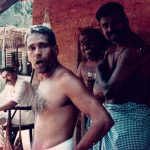Festivals: London, Pesaro, Nantes, Brussels, San Francisco, Fribourg, Munich, Mannheim.
Rotterdam, Ljubljana, Singapore, Hongkong, Fukuoka, Brisbane, Durban, Tehran, Toronto, New York, Chicago, Hawaii and Sao Paulo among others.
Awards: International Film Critics Prize, Singapore. INTER FILM Prize, Mannheim National Awards for Best Actor and Best Malayalam film.
Kerala State awards for Best Film, Best Director, Best Actor and Best Story, Special award for M.R.Gopakumar (Acting).
In Short
Thommi is an innocent immigrant labourer from Kerala who has moved to neighbouring South Karna taka in search of land and a new life. There, his life gets inextricably entangled with that of Patelar, a degenerate and whimsical landlord. His inability to put up any resistance in the beginning eventually leads to Thommi’s total surrender to Patelar, For Thommi, Patelar proves to be both depriver and benefactor at the same time.
The Background

During the Second World War, when food and supplies were scarce in the princely state of Travancore, poor Christian farmers sold all their belongings and set •out northwards to better their fortunes. They were drawn by rumours that large tracts of virgin land were available at low prices in the Wynaad hills of British Malabar. Many succumbed to malaria rampant in the area. Some went back defeated. A few held on against all odds. After a brave but futile battle, a small number – paupers now – moved further north into South Karnataka, with no option but to encroach on forest land.
There, the settlers found themselves at the mercy of the Patels (village chiefs) who had been empowered by the British to collect taxes and enforce law. Although the British rule ended in 1947, the institution of Patels continued until the early Sixties when land legislation replaced them with regular revenue officials.
The Story
Thommi and his wife Omana are among the last of the immigrants to arrive in South Karnataka. They, like the others, manage to illegally fence off a few acres of land and start cultivating it. It is by sheer chance that Thommi happens to catch the attention of Bhaskara Patelar, once chief of the village. Though now shorn of his legal powers, the people around him fear to question the Patelar’s authority. He terrorizes Thommi into submission and rapes his wife, A humiliated Thommi wants to avenge his dishonour, but the urge to survive ties his hands – turns him mute.
Patelar finds Thommi a job as bartender in a toddy shop and embarks on an open affair with Omana. Eventually, Thommi becomes principal aide and accomplice in the mindless crimes Patelar commits.
Although he loves his gentle wife Saroja and their only son dearly, Patelar cannot stand Saroja’s efforts to restrain him. Unable to put up with the idea of living under her watchful eyes, Patelar decides to do away with her. Taking Thommi into confidence, Patelar hatches a plot to kill Saroja. The plan misfires – Thommi gets gravely wounded instead.

Undaunted, Patelar next comes up with a plan to dynamite the holy fish at the temple ghat. He drags a reluctant Thommi to help him in this sinful act – but faith prevails. The dynamite fails to explode.
In another act of violence, Patelar assaults Yusoof Picha, a wealthy trader, and leaves him near dead on the roadside. Just to show Thommi that he has only one master.
The incident involving Kuttapparai’s son and his young bride rouses the combined wrath of Patelar’s many adversaries.
Determined to put an end to his evil ways, Yusoof Picha and Kuttapparai plot to kill Patelar when he visits Thommi. They manage to convince Thommi that it will be for his own good.
The crucial moment arrives. Shots are fired in the dark. But Patelar escapes with minor injuries.
Patelar finally executes his plan to kill his wife. Saroja is throttled to death. The attempt to fake the death as suicide fails. Patelar goes underground. Days later, a shaken Patelar visits Thommi in the dark of night to ask Thommi to go with him. He is hopeful of finding shelter in his nephew’s house in the town.
Turned down by his cowardly nephew, Patelar, along with Thommi, sets out to find refuge in the wilderness of the forests. There, inescapably, Patelar meets his nemesis.
The grief-stricken Thommi slowly regains his composure. He removes the gun from the firm grip of the dead Patelar and throws it into the waterfall thundering below. Beyond the wilderness, there await life, hope and Omana…
Director’s Statement
The film tells a parable-like story. Whereas it is true to recent history, and can very well stand up as an authentic social document on the life and times of the Keralite immigrants in the feudal setting of a neighbouring State, the concerns of the film go beyond mere realistic portrayal.
I have used the plot of the story to explore the subterranean landscape of the human mind. Here, terror – the oppressive form of power – joins hands with servility in a pathological alliance of interdependence. Each of them, oppressor and oppressed, is the source of sustenance of the other. Vidheyan is a study of the psychology and structure of power – as also an attempt to examine what lies buried beneath an obsessive servility.
Filmmakers and Critics Say
Vidheyan is already being discussed as a metaphor for servility, yet its surface is replete with sheer joy…Power is magnificently captured here.
This placing of dominance in a petty village culture is there in a myriad Indian films. But here the nuances are legion and each is lighted up with clarity.
– Iqbal Masud, Indian Express Sunday Magazine
Vidheyan can be viewed as a critique of the status quo, as a plea for change; its multi-layers are open to subjective interpretation though surfacially the plot is about the hopelessly obsequious Thommi and the village despot.
Boasting of outstanding performances by both the lead players, Vidheyan is poised to become the most discussed film of the year.
– Khalid Mohamed, The Times of India
Vidheyan at every stage is a comment on our times and our history. It is an allegory of colonisation, a mantle that Patelar inherits. It subtly conveys the love-hate relationship that ruler-and-subject enjoy and suffer. It shows how the ruler and the ruled become two sides of one coin and how cruelty and domination usurp the common man’s rights, giving way to new rules that consolidate and glorify the ruler.
–Uma da Cunha, The Pioneer
No two Adoor films are alike and yet his signature is stamped in an unmistakable fashion. ‘Vidheyan’ could not be more different than its predecessor.
The film forces you to reflect upon the nature of evil and the dilemma of vicarious satisfaction from the exercise of power. Without underlining it, Adoor nudges you into enlarging the metaphors in ‘Vidheyan’.
– Maithili Rao, The Hindu
No film of his would be the same without agreement, disagreement, argument and discussion. Which is why it all becomes so exciting. Every time.
– Amita Malik, The Sunday Statesman
Like all of Adoor’s earlier, films which delve into the dilemma of modern living, this film too examines the relationship between power and servility and is a profound and disturbing metaphor of the times.
– Ramesh Menon, India Today
Gopalakrishnan has made a film that is a masterly exposition of the creation of power, its validation through social and individual endorsements, and how it produces a servility which acquires overtones of sin.
–K.G. Kumar, Business India
Credits:
- Script, Dialogue & Direction : Adoor Gopalakrishnan
- Production Company: General Pictures
- Add: Chief Assistant: Meera Sahib
- Based on the short story titled ‘Bhaskara Patelarum Ente Jeevithavum’ by Zacharia
- Make-up: P.N.Mani
- Stills: Rajasekharan
- Producer: Ravi
- Camera : Ravi Varma
- Sound : Devadas & Krishnanunni
- Editing: M. Mani
- Décor: Sivan
- Music : Vijaya Bhaskar
- Format: 35 mm Colour
- Duration:112 Minutes
- Year of Production 1993
Cast & Characters:
- Mammootty (as Bhaskara Patelar )
- Gopakumar (as Thommi )
- Tanvi Asmi (as Sarojakka, Patelar’s wife )
- Sabita Anand (as Thommi’s wife )
- Ravi Vallathol (as Patelar’s nephew)
- Soman, Aliyar, M.K.Gopalakrishnan (as Patelar’s aides )
- Azees (as Sarojakka’s brother)
- Appachan (as vicar )
- Mavelikkara Ramachandran(as villager )
- S.S.Nair (as a settler)
- P.V. Thampi (as helper in the toddy shop )
- Sarojini Shetty (as the accused woman )
- Devadiga, Naveen, (The conspirators )
- Lakshman(as the absconder )
- Asha(as village woman)
Working Stills:
|
 |
|
Enquiries :
General Pictures,
Beach Road, Quilon- 691 001,
Kerala, India:
Tel: (91-474) – 75278, 76391
FAX: (91-474)78285.
or:
Adoor Gopalakrishnan,
Darsanam, Trivandrum- 695017,
Kerala, India.
Tel: 91-471-446567 FAX: 91-471-444287
 During the Second World War, when food and supplies were scarce in the princely state of Travancore, poor Christian farmers sold all their belongings and set •out northwards to better their fortunes. They were drawn by rumours that large tracts of virgin land were available at low prices in the Wynaad hills of British Malabar. Many succumbed to malaria rampant in the area. Some went back defeated. A few held on against all odds. After a brave but futile battle, a small number – paupers now – moved further north into South Karnataka, with no option but to encroach on forest land.
During the Second World War, when food and supplies were scarce in the princely state of Travancore, poor Christian farmers sold all their belongings and set •out northwards to better their fortunes. They were drawn by rumours that large tracts of virgin land were available at low prices in the Wynaad hills of British Malabar. Many succumbed to malaria rampant in the area. Some went back defeated. A few held on against all odds. After a brave but futile battle, a small number – paupers now – moved further north into South Karnataka, with no option but to encroach on forest land. Undaunted, Patelar next comes up with a plan to dynamite the holy fish at the temple ghat. He drags a reluctant Thommi to help him in this sinful act – but faith prevails. The dynamite fails to explode.
Undaunted, Patelar next comes up with a plan to dynamite the holy fish at the temple ghat. He drags a reluctant Thommi to help him in this sinful act – but faith prevails. The dynamite fails to explode.








